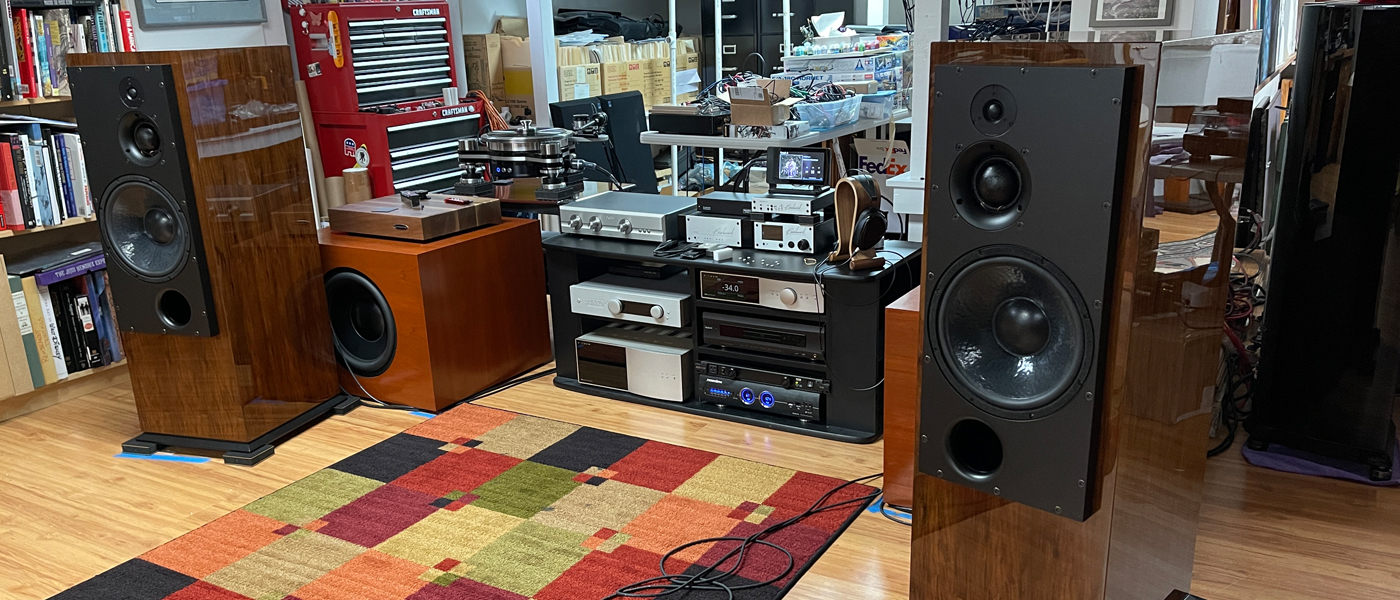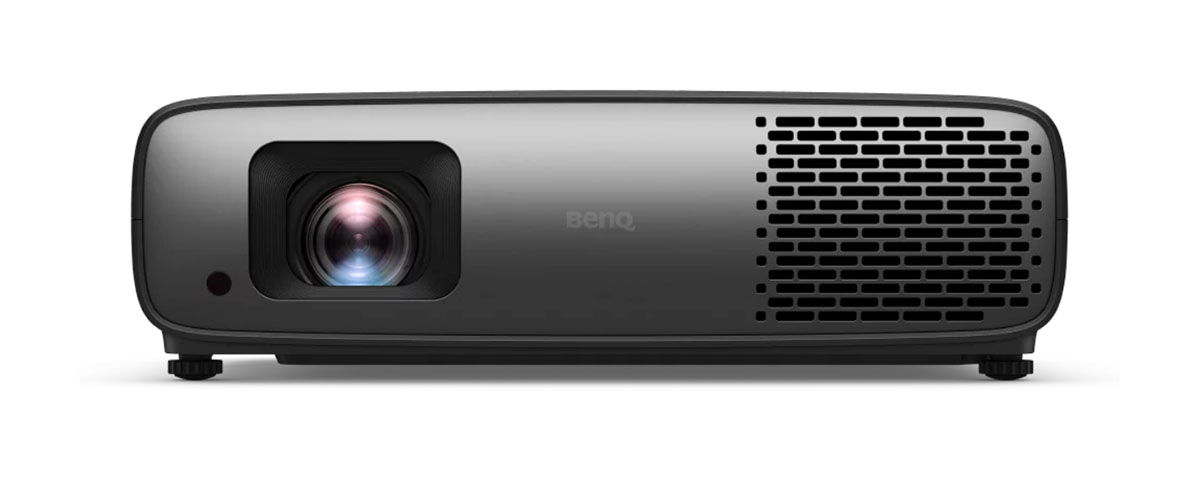The BenQ HT4550i 4K LED Projector (known outside the US and Canada as the W4000i) has a single-chip DLP 4-LED light engine with tremendous output. It also covers 100% of the DCI-P3 color gamut and supports HDR10, HDR10+, and HLG. HDR-PRO optimized tone mapping tailors HDR content to suit the projector’s capabilities with a multi-zone dynamic contrast feature that works incredibly well. It also includes generous lens shift and zoom, an internal speaker, and Android TV.
BenQ HT4550i 4K LED Projector Highlights
- Single chip DLP projector with 4-LED light engine.
- Vertical and horizontal lens shift with zoom.
- 100% coverage of DCI-P3 color gamut.
- HDR-PRO optimized tone mapping.
- Multi-zone dynamic contrast.
- 3D support.
I’ve been reviewing BenQ projectors for over a decade and during that time, I’ve seen their products continue to evolve and improve with each new generation. They have managed to optimize the advantages of DLP technology with a balance of smart engineering and quality components, all while maintaining value.
Their latest offering is the HT4550i 4K LED Projector, known outside the US and Canada as the W4000i. Like other 4K DLPs, it uses pixel shift technology to achieve Ultra HD with 8.3 million addressable pixels from a single chip of 1920×1080 resolution. BenQ has been using this technique for a while and the HT4550i is the best yet. Right out of the box, the image is super sharp.
BenQ has really upped the contrast quotient here as well. DLP doesn’t have the native dynamic range of LCD or LCoS but with some clever engineering, BenQ has made some serious strides. For HDR signals, the HT4550i uses a proprietary tone-mapping technique called HDR-PRO. It ensures that all detail is rendered regardless of the peak level used to master it. To this, BenQ adds a contrast enhancer that uses over 1,000 zones of adjustment to make shadow areas deeper and bring out bright highlights.
Color has also been given an upgrade. The HT4550i covers 100% of DCI-P3 using an internal filter. That color is incredibly accurate too. My sample measured so well out of the box that I couldn’t make it any better with calibration.
The HT4550i is already shaping up to be one of the best DLP projectors I’ve reviewed and I’m just getting started. Let’s take a look.
Type:
Single-chip DLP
Native resolution:
1920×1080 (accepts up to 3840×2160 @ 60Hz)
Color depth:
10-bit
HDR:
HDR10, HDR10+, HLG
3D:
Frame-pack, side-by-side, top/bottom
Light source:
4-LED
Service life:
20,000-30,000 hours (LED mode dependent)
Light output (mfr):
3,200 ANSI lumens
Throw ratio:
1.15-1.5:1 (zoom range 1.3x)
Lens offset:
100%
Lens shift:
0-60% vertical, +15% horizontal
Speakers:
1x 5w chambered, treVolo tuned
Video connections:
3x HDMI 2.0b, 1 w/eARC
Audio connections:
1x optical out (multi-channel)
Additional connections:
RS-232, RJ-45, USB, 12v trigger
Dimensions:
16.54 x 5.31 x 12.28″ (W x H x D)
Weight:
14.55lbs
Warranty:
3 years
MSRP:
$2,999
Website:
Company:
SECRETS Tags:
benq, ht4550i, w4000i, dlp, 4k, ultra hd, hdr, hdr10, dci-p3, led, home theater projector
The BenQ HT4550i is the successor to the HT3550i which I reviewed here four years ago. I would call it a semi-compact projector as it is larger than most portable models but smaller than most home theater displays. At 14.5 pounds, it has some decent heft and a solid build. Size-wise, it’s easy to install just about anywhere, table, ceiling, stand, shelf; whatever works in your theater or media room.
The lens is more flexible than most compact DLPs because it includes a decent zoom range and both horizontal and vertical shifts. Shift is rare among DLPs in general and the 60% vertical range of the HT4550i is even rarer. You also get up to 15% horizontal shift. All of this is accomplished with a pair of dials while the zoom and focus are dialed in with two-barrel adjusters found under a sliding door atop the unit. The adjustments are firm and precise and in my time with the projector, they did not drift.
Secrets Sponsor
The HT4550i’s insides are where the real magic happens. Most DLPs are bright but this one can put an honest 270 nits on the screen in the Eco low power mode. This means lots of light without much heat or fan noise. Speaking of light, that comes from a 4-LED engine rather than a UHP lamp or laser. Service life is between 20,000 and 30,000 hours depending on the light mode used. And you can track the number of hours spent in each mode in the OSD, very cool.
The imager is a single 1920×1080-pixel DLP chip that uses shift technology to display a 3840×2160 image with each pixel addressable. In practice, the picture is clearly sharper than what a 1080p projector is capable of. The shift can’t be turned off, so all incoming signals are displayed in Ultra HD and the HT4550i reports itself to video sources as a 3840x2160p display.
Signal support is broad with bandwidth up to 3840×2160 at 60Hz with 10-bit color. You can also play games in 1920×1080 up to 240Hz which is super cool. You’ll need a gaming PC for this. If you hook up a PS5 or Xbox One, you can play at 1920×1080 at 120Hz. There is no support for VRR. The HT4550i also accepts 3D signals in frame-pack, top/bottom, and side/side formats. You can use any brand of DLP Link glasses which sync up automatically. I used my trusty pair from Xpand.
HDR10 and HDR10+ are also supported. The latter format includes dynamic tone-mapping just like Dolby Vision and you’ll need HDR10+ encoded content to take advantage. HDR10 has static tone mapping where the material is mastered to a fixed output level, usually 1,000 nits. Obviously, that means a display that tops out at less than 300 nits like the HT4550i (and nearly all projectors) must use its own internal tone mapping to render full detail. BenQ gives the user control over this process with a five-level HDR Brightness control that can be used to dial in content mastered to different peaks.
Color has definitely seen an advancement since the HT3550i. The filter used to render wide gamut color is still in play, but the gamut is a good deal larger in the HT4550i. I measured 100% coverage of DCI-P3 which at this price point is unmatched in my experience. Accuracy is there too as you’ll see below in my tests. This projector comes from the factory with no need for calibration.
DLPs have never been known for high contrast but the HT4550i employs a few bits of clever engineering to add image depth. Using the Smart Eco light mode creates a full field dimming effect that doubles contrast to just over 2,000:1. In HDR mode, BenQ uses a technique called HDR-PRO to selectively dim 1,000 zones or more, similar to what Mini LED TVs can do. I can attest from observation that this technology works very well. More on that later.
The HT4550i includes many integration features starting with an Android TV dongle that plugs into a special hidden HDMI port. This turns the projector into a worthy television replacement if you can find everything you’re looking for on streaming services. You also get two more HDMI 2.0b ports, one of which supports eARC so you can pipe the sound from the Android TV dongle out to a receiver or processor. Automation systems can use RS-232 or LAN ports, and there’s a 12-volt output to trigger nearby devices like roll-up screens or window shades. There’s even a built-in speaker with nine watts of power along with a multi-channel S/PDIF and a 3.5mm analog audio output.
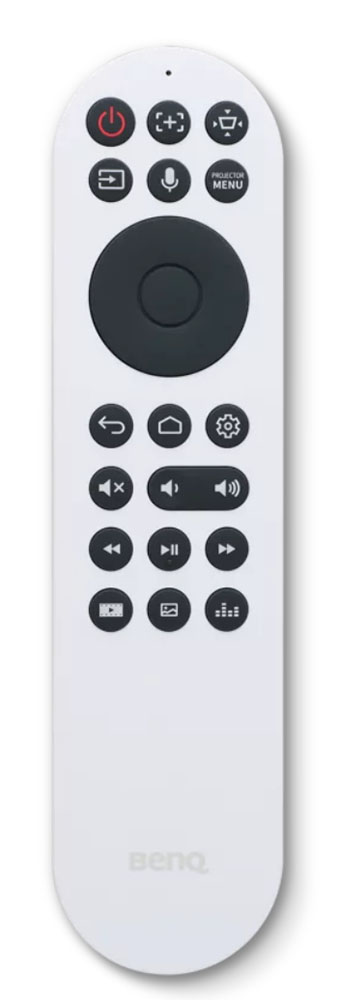
The remote is a new design for BenQ and includes a backlight. My only gripe is that it doesn’t come on until you actually press a button and then it only stays lit for a few seconds. But the wand is simple enough that you’ll find your way to the right keys simply by feel, just as I did. It controls the projector and the Android TV interface. Which, by the way, has Netflix with support for 4K and HDR.

You also get a remote that pairs with the Android dongle via Bluetooth. It has dedicated buttons for Netflix, Disney+, Prime and YouTube. It is not backlit but like the main wand, it’s pretty easy to operate by feel.
Installing the HT4550i was straightforward. It has a 100% lens offset which means the lens axis, unshifted, must line up with either the top or bottom edge of the screen. Since there is up to 60% shift available, I had some flexibility. I aimed the lens between the bottom edge and center of the screen and used the shift dial to center the image. It squared up easily thanks to two threaded feet in the front. There is an auto keystone feature available, but I didn’t use it.
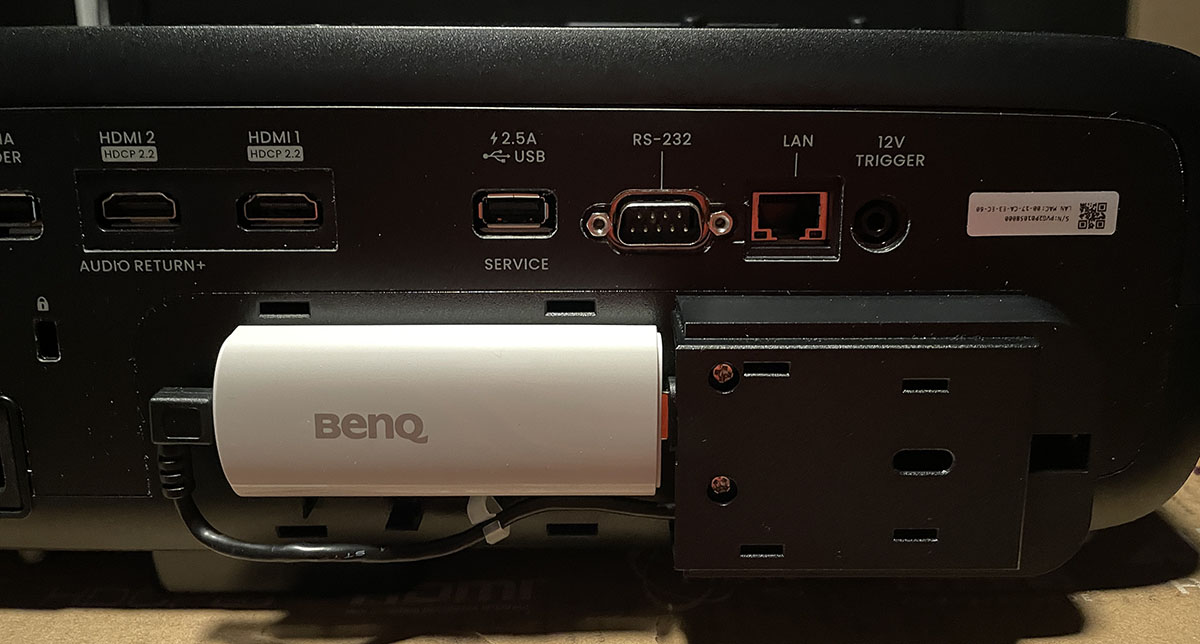
The HT4550i runs through an intuitive wizard when you first power it up. It reminded me to install the Android dongle and pair its remote but I skipped that part so I could get to calibration and testing. When I installed it later, I had to find a Phillips-head screwdriver to remove the cover in the back. There’s a tiny screw there that is easy to lose. The dongle plugs into a mini-HDMI male connector, then you plug in a little USB power cable. It all hides neatly beneath the cover once you’re done.
Logging into Android was just a matter of entering my Google ID. I was pleased to see Netflix right on the home screen. A few minutes later, I was looking through my watchlist and noting that the HT4550i is the first Android TV projector I’ve seen that not only supports Netflix out of the box but includes HDR and 4K; meaning that this is the first projector review where I won’t be saying, “I hooked up my Apple TV 4K.” This is no reflection on BenQ but a statement on the relationship between Google and Netflix. Let’s just say, it’s about time.
Secrets Sponsor
The story of the HT4550i’s calibration is going to be very short. Not only did it not require one, but I also couldn’t improve upon its out-of-box state with any adjustments. Not that there aren’t options. In fact, there is now an 11-point grayscale control to go with the 2-point one. And you get a full suite of color management and accurate gamma presets. There are four SDR picture modes plus 3D, four HDR presets, two ISF memories, and a User mode. But all you need is the default, Cinema, for perfect Rec.709 color, D65 white point, and 2.2 gamma. The default HDR10 mode is equally on-point. It includes an HDR Brightness control with five levels so you can tailor content mastered to different levels to achieve optimal quality.
The HT4550i has a few new features in its OSD that I tried out during my viewing sessions. Light Source mode now includes a 100-step manual brightness slider in addition to Eco, Normal, and SmartEco. That last one is my choice as it provides the best contrast. For HDR content, you’ll want to be sure and turn on the Wide Color Gamut option. It employs an internal filter that cuts brightness by around 40%. Luckily, in the Normal light mode, you still get over 171 nits of output which is plenty.
Cinema Master is a set of options that affect resolution and video processing. Pixel Enhancer 4K tweaks the amount of shift effect used by the DLP chip. It has 20 levels, and I found the sharpest picture around 5-6. There is also a frame interpolation feature called Motion Enhancer 4K. It creates different degrees of the “soap opera” effect, so I left it off. The HT4550i supports 24p input but I noticed a bit of judder in test patterns until I found an option in the Display menu called 24p True Cinema. This is a frame multiplier that runs 24p signals at 96Hz and it significantly cleaned up content coded at that rate. That option should be turned on by default.
After I ran my full suite of tests, I tweaked just the settings below before settling in for a few movies.
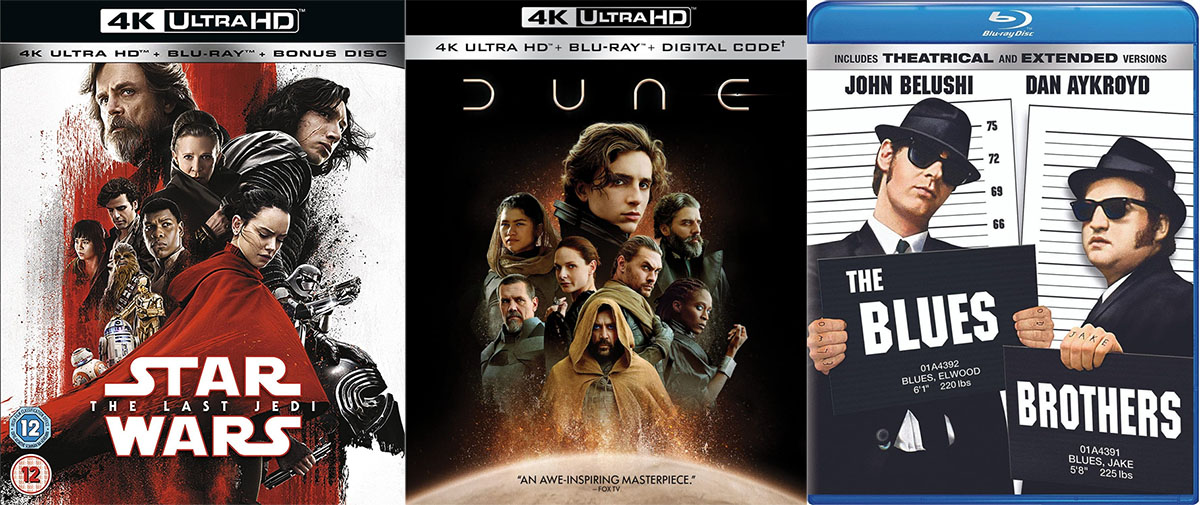
I fired up my trusty Panasonic DP-UB9000 Ultra HD Blu-ray Player to watch Star Wars Episode VIII: The Last Jedi. I always focus on two scenes, the battle between Rey, Ren, and Snoke’s guards and the battle on Crait. Both are rife with deep shades of red that just don’t translate in SDR. You need a good HDR display with a wide color gamut to truly see the director’s intent and the HT4550i delivers better than nearly every projector I’ve ever reviewed. Only a few premium models I’ve seen in demos can match the color gamut BenQ is delivering for just $2,999. The HDR effect is extremely well done too thanks to the HDR-PRO zone dimming feature at work. I was able to tweak the HDR Brightness control down a click to make blacks deeper while still retaining full shadow detail.
Dune, the 2021 version, has two torture tests in its two-and-a-half-hour run. One is the monochrome desert landscapes which rely on a display’s intra-image contrast to show any detail at all. The second is the dark and foreboding interiors on both Caladan and Arrakis. Most DLPs will render the latter in murky gray if they are to show any detail at all but the HT4550i’s HDR-PRO creates true blacks. I will concede that a good LCoS projector can do a bit better, but this DLP comes closer to that standard than any other I’ve seen. Its HDR is truly superior to what’s come before from BenQ and other companies.
I finished my Blu-ray viewing with a trip through an 80s classic, The Blues Brothers. This 1080p SDR transfer is a grain fest at best and often looks washed out but the HT4550i managed to wring out more saturation and vibrance than I usually see. The film grain was extremely well controlled with noise reduction set to Low. It managed to smooth out the image without reducing sharpness. The shift-based 4K really works here.

I started with an easy test of the Android TV interface by firing up Netflix. Finally, support for this service is built in and you get 4K and HDR too. Dolby Vision content like Formula One: Drive to Survive is presented in HDR10. And it looks amazing. Though I’m a bit spoiled when watching this on an LG OLED TV, the HT4550i does a decent job at trying to fool me into thinking I’m watching a giant flat panel in my theater. The image is razor-sharp with deep contrast and saturated color. Reds are once again the star every time a Ferrari rolls by. Flesh tones are extremely well rendered with natural hues and plenty of fine detail like freckles and razor stubble, something the barely-old enough-to-shave drivers of today’s racing generation have in abundance.
For a more cinematic experience, I watched an episode of Lost in Space from Season 3 which has an HDR encode. This is one of the best examples I’ve seen from Netflix or any streaming service. The format is truly done justice here and HT4550i delivered yet again. I could tailor the look with the HDR Brightness control which I found very handy. It would be nice if there were a dedicated remote button for it but there is not. The color was rich and deep, and the blacks were true.
I finished up my viewing with an episode of BBQ USA, now in its second season. The video looked bright and colorful as expected but my main focus was on sound. I used the internal speaker for this one and found it very clear with a broad frequency response thanks to BenQ’s trademark treVolo tuning. It was a bit quiet though. I could turn up the volume fully and listen without distortion but there wasn’t much presence there. Size does matter and a single nine-watt speaker isn’t going to fill more than a small room with sound. If you sit right behind the HT4550i, you can hear the dialog clearly, but you won’t be waking up the neighbors.
To test the HT4550i, I set up my usual suite of benchmarks using the latest version of Calman from Portrait Displays. To measure color, I used an X-Rite i1 Pro Spectrophotometer, and for luminance, an X-Rite i1 Display Pro tri-stimulus colorimeter. Signals were generated by an Accupel DVG-5000. HDR signals were generated by the same unit with an HD Fury Integral in the signal path.
SDR Tests
I ran all SDR tests in the HT4550i’s default Cinema picture mode with the light source set to Eco.
This is going to be a really easy calibration because, as you can see above, the HT4550i is already spot-on from the factory. Every unit is set before shipment and includes a calibration report in the box. Clearly, BenQ has done a good job here. Grayscale tracking is visually perfect with all errors below 3dE. Gamma tracks almost perfectly on the 2.2 reference line. There was literally no benefit to adjustment. I could not improve upon this result.
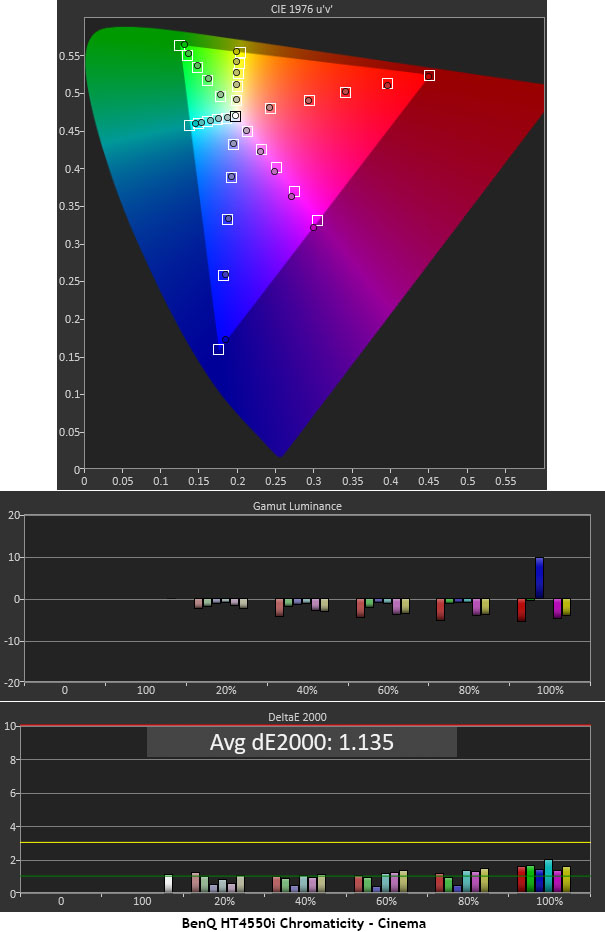
The same is true for the color gamut test. With an average error of 1.14dE, the HT4550i has visually perfect color for SDR content. It tracks the Rec.709 gamut as it should with all errors below 2dE. Luminance levels are also very tight with near perfect balance throughout the brightness range of all colors. You are looking at reference-level performance here. I’ve only seen a few very expensive professional monitors that can even come close to this level.
HDR Tests
The HT4550i automatically switches to HDR when the appropriate signal is applied, either HDR10 or HDR10+. I used HDR10 for these tests. There are four additional picture modes available. I used HDR10 to generate the charts below.
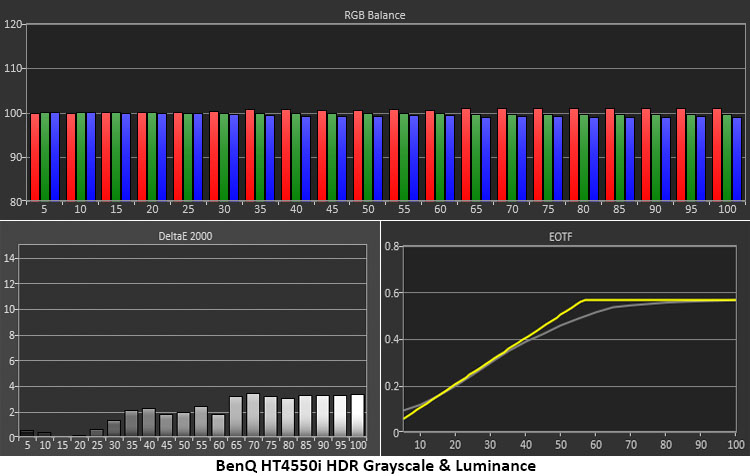
Grayscale tracking in HDR mode is visually perfect with just a slight elevation in red over 65% brightness. This error is nearly impossible to spot in actual content. You might see a bit of warmth when watching hockey or THX 1138, but realistically, this is pretty awesome. The EOTF makes a gradual transition to tone-mapping at 55% which is an acceptable result. Again, this is not an error that will be visible to the naked eye. For fixed metadata formats like HDR10, the HT4550i’s HDR Brightness control can alter the tone mapping for optimal image quality.
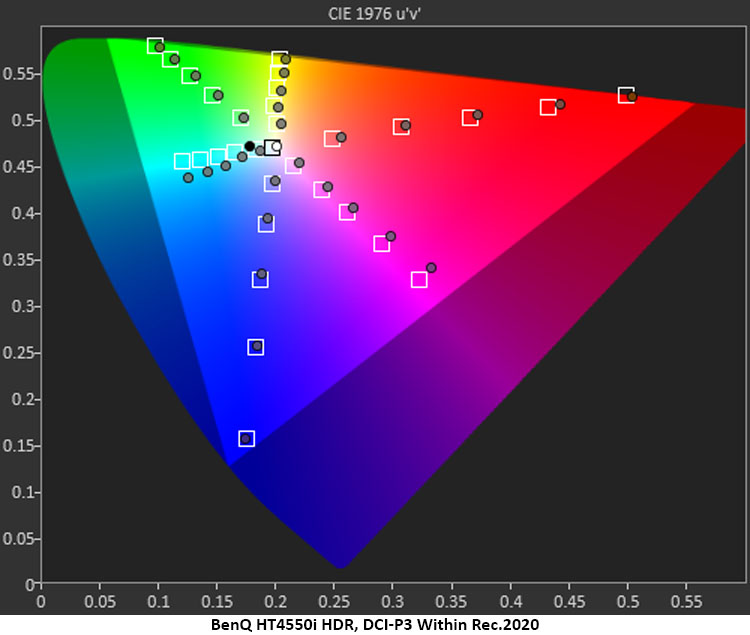
The HT4550i pretty much nails the HDR color gamut tests. Saturation is well-controlled in all six colors with only slight hue errors noted in cyan and magenta. This chart indicates that HDR content will be well-detailed in all areas of the image and color will look natural regardless of brightness level.
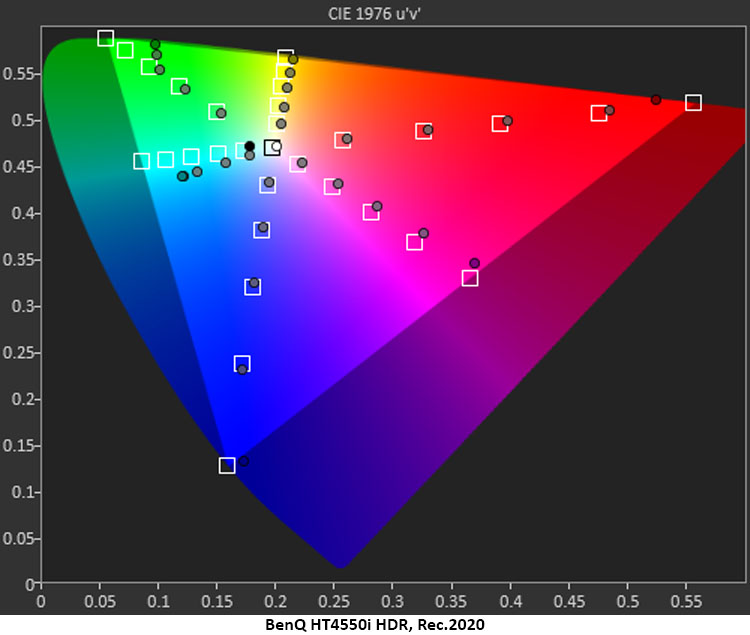
The Rec.2020 chart is impressive in that it also hits all the inner targets and only misses when the HT4550i runs out of color at around 90% saturation. That means HDR content mastered to Rec.2020 (which is most of it), will be rich with detail and depth. Again, there are slight hue errors in cyan and magenta, but these are minor issues. This is an excellent performance.
Brightness and Contrast
The HT4550i’s 4-LED light engine delivers high brightness in all modes of operation. In my small theater, I only needed the Eco mode to see a bright and vivid image. Here are the results for the different light source modes, HDR and 3D.
SDR Eco
SDR Normal
SDR SmartEco (recommended)
HDR10 SmartEco
3D (measured through Xpand active-shutter glasses)
Takeaway: 3D image quality is fair with just .02% crosstalk so there are no visible artifacts. It’s relatively bright but the contrast isn’t great. HDR contrast looks even better than the numbers indicate thanks to the HDR-PRO feature which uses over 1,000 dimming zones to darken shadows and brighten highlights. My test patterns don’t indicate the true intra-image contrast which from visual observation, is quite high. For all content, I recommend the SmartEco light mode which effectively doubles contrast to over 2,000:1 which is better than most DLPs can boast.
Video Processing
The HT4550i had no problem with 1080i de-interlacing and was able to lock onto 2:2 and 3:2 cadences in less than one second. For 24p content, I had to turn on 24p True Cinema to engage the 96Hz mode. This cleans up judder significantly. I was able to verify BenQ’s claims of 8.7ms input lag with Fast Mode engaged when connected to a gaming PC equipped with a GeForce RTX 4090 video card, running 1920×1080 at 240 Hz. The HT4550i is well-suited for gaming of all types.
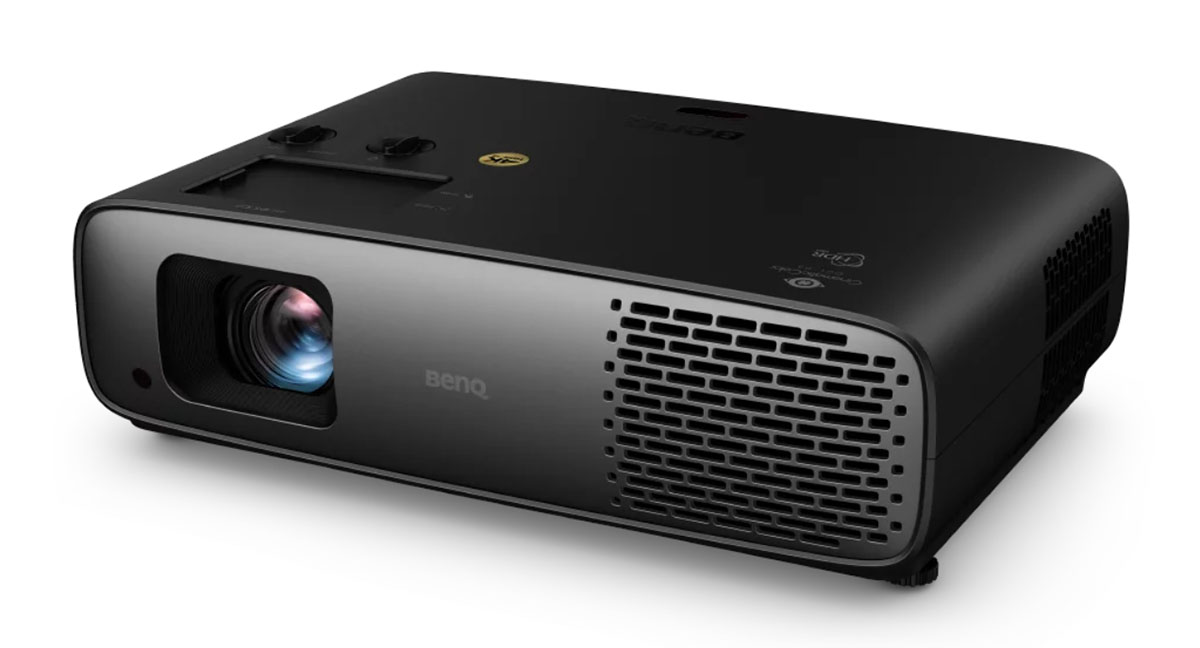
BenQ’s HT4550i delivers fantastic HDR and tremendously saturated accurate color for just $2,999. It easily competes with projectors costing two and three times more.
- Bright, sharp, and colorful image.
- Better HDR than most projectors of any price.
- Spot-on accuracy out of the box.
- Android TV finally supports Netflix 4K and HDR content.
- No flaws of consequence
I’ve reviewed a lot of BenQ projectors during the past decade (17 to be exact) and the HT4550i is easily my favorite. It had me during testing when I discovered that it didn’t need calibration. As in, it was literally perfect right out of the box. Then it told me that its Android TV feature now supports Netflix with HDR and 4K. Then it showed me some of the best projector HDR I’ve ever seen. I am not exaggerating when I say that only the top-of-the-line $16,000 JVC DLA-NZ8, which I’ve only seen in demos, can compete with the HT4550i’s HDR, and it’s only a little better. BenQ’s HDR-PRO with zone dimming is a real breakthrough for DLPs and value-oriented projectors.
The HT4550i is bright enough for small to medium theaters and media rooms. You can have some room lights on if you use an ambient light-rejecting screen. It supports every current signal format and even plays 3D movies if you’re so inclined. The built-in Android streaming is far better than before. Installation is easy thanks to the lens shift and zoom features. So, not only is it one of the best DLPs I’ve ever watched, but it is also full-featured. There is nothing to complain about here. BenQ’s HT4550i 4K LED Projector is one of the best projectors I’ve ever reviewed and in the value genre, it blows all its predecessors away. It receives my Highest Recommendation.


